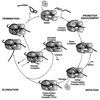Information processing by RNA polymerase: recognition of regulatory signals during RNA chain elongation
- PMID: 9642176
- PMCID: PMC107278
- DOI: 10.1128/JB.180.13.3265-3275.1998
Information processing by RNA polymerase: recognition of regulatory signals during RNA chain elongation
Figures




References
-
- Aivazashvili V A, Bibilashvili R S, Vartikyan R M, Kutateladze T A. Relationship between the primary RNA structure and pulse elongation in vitro by Escherichia coli RNA polymerase. A model. Mol Biol. 1982;15:711–722. - PubMed
-
- Arndt K M, Chamberlin M J. RNA chain elongation by Escherichia coli RNA polymerase. Factors affecting the stability of elongating ternary complexes. J Mol Biol. 1990;213:79–108. - PubMed
-
- Artsimovitch, I., and R. Landick. Submitted for publication.
-
- Asturias F, Meredith G, Poglitsch C, Kornberg R. Two conformations of RNA polymerase II revealed by electron crystallography. J Mol Biol. 1997;272:536–540. - PubMed
Publication types
MeSH terms
Substances
LinkOut - more resources
Full Text Sources

